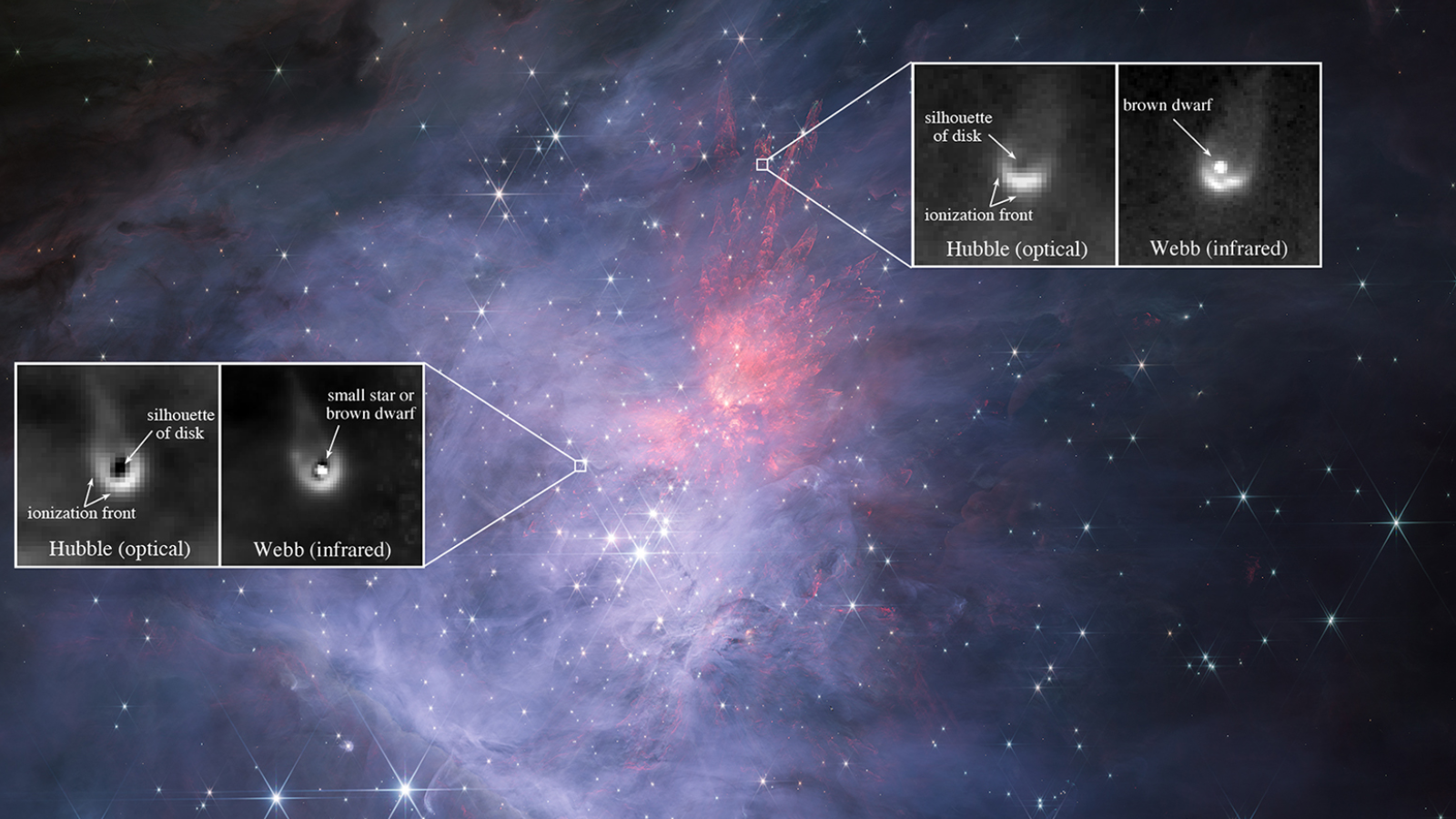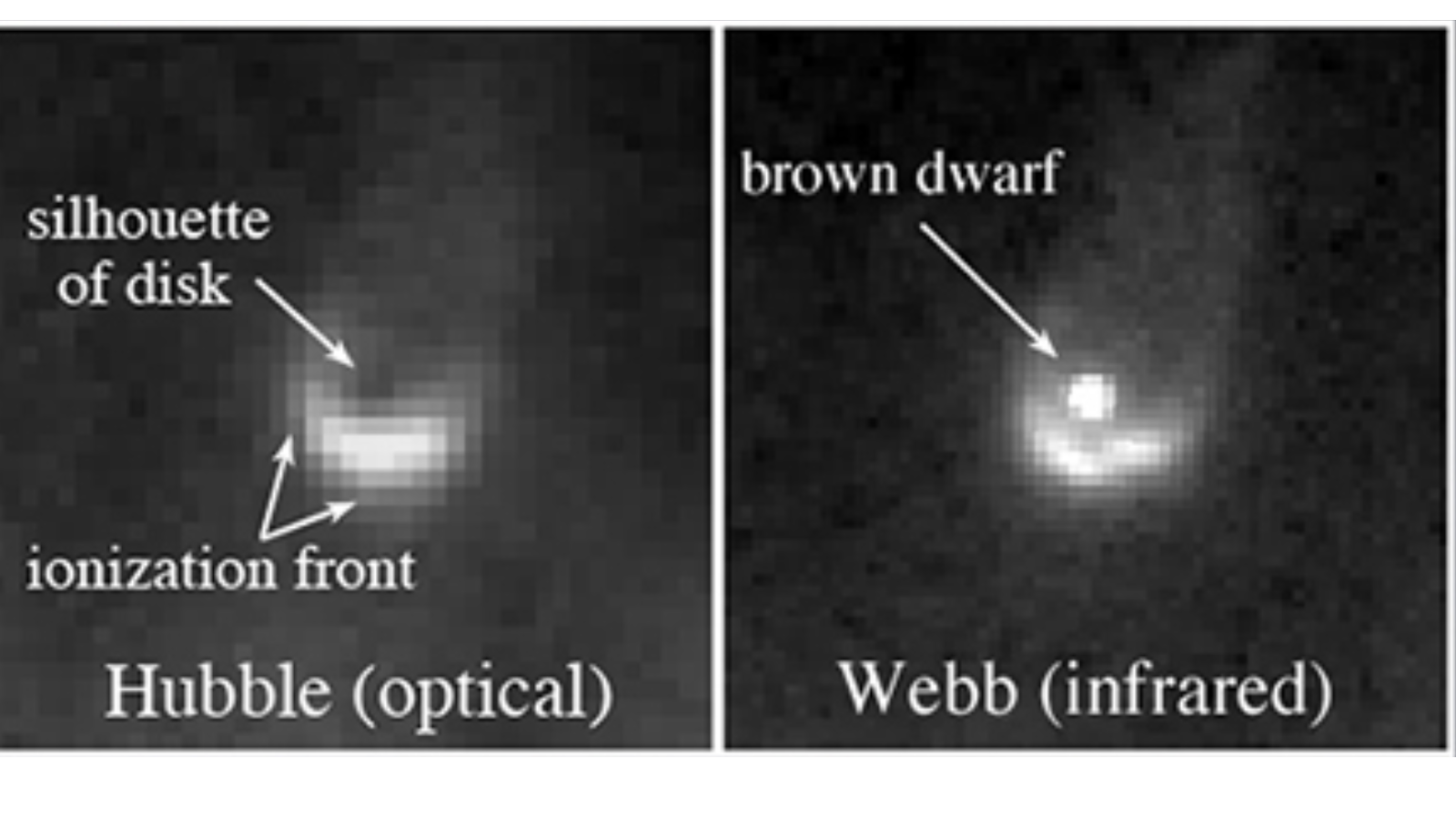Can 'failed stars' have planets? James Webb Space Telescopes offers clues
"This information will help us fill in the gaps in our knowledge of how brown dwarfs form and their relationship to stars and planets."

Using the James Webb Space Telescope, astronomers have discovered that planet-forming disks in the Orion nebula actually surround "failed stars," or brown dwarfs. This is the first confirmation that planet-forming, flattened clouds of gas and dust called "protoplanetary disks" surround these peculiar cosmic objects.
The team discovered this while using the James Webb Space Telescope (JWST) to follow up on observations of protoplanetary disks, or "proplyds," illuminated by ultraviolet light in the Orion Nebula. Those observations were collected by the Hubble Space Telescope.
These findings could help scientists understand how brown dwarfs form, as well as why they can't cross the final hurdle needed to become a fully-fledged star. Additionally, the discovery could help determine if these free-floating bodies can eventually have orbiting planets of their own despite failing to become proper stars.
Brown dwarfs get their somewhat unfair nickname of "failed stars" because they form directly from vast clouds of gas and dust like stars. However, they fail to gather enough mass to create the pressure and temperature needed in their cores to trigger the nuclear fusion of hydrogen to helium, the process that defines a star's main sequence lifetime.
Brown dwarfs have masses between 13 and 75 times that of Jupiter, or 0.13 to 0.75 times the that of the sun, and have cool temperatures. Thus, they emit faint, low-energy infrared light.
"Stars are born within massive clouds of gas and dust in space that can be light-years across, which are called nebulas," team co-leader Kevin Luhman from Eberly College of Science at Penn State University said in a statement. "For decades, astronomers suspected that, soon after a star coalesces within a nebula, planets are born within a disk of gas and dust surrounding the newborn star, known as a protoplanetary disk."
Brown dwarfs may not fail as planetary parents
It wasn't long after Hubble's launch in 1990 that NASA's pioneering space telescope captured direct images of protoplanetary disks in the Orion nebula. Located just 1,500 light-years away, Orion is the closest large star-forming region to Earth, home to around 2,000 newborn stars.
Get the Space.com Newsletter
Breaking space news, the latest updates on rocket launches, skywatching events and more!
"Some of the objects born in nebulas like Orion have masses that are too small for them to undergo hydrogen fusion, so they are cool and faint and do not qualify as full-fledged stars," one of the team leaders, Catarina Alves de Oliveira, head of the Science Operations Development Division at the European Space Agency (ESA), said in the statement. "These star-like bodies that lack fusion are known as brown dwarfs. The question is, can we find proplyds around any of the brown dwarfs in Orion?"

Indeed, some of the proplyds seen by Hubble in the Orion nebula did seem to have faint objects at their centers that could be brown dwarfs. The problem, though, was that the observations gathered by Hubble weren't sensitive enough to determine whether these faint bodies had the cool temperatures associated with these failed stars.
That's where the JWST steps in — the most sensitive infrared space telescope ever built by humanity. It is perfectly suited for measuring the temperatures of faint objects in the Orion Nebula that might be brown dwarfs, including the proplyds seen by Hubble three decades ago.
The astronomers performed spectroscopy on several of the brown dwarf candidate proplyds in Orion, discovering that at least 20 of them are cool enough to be named as brown dwarfs. The smallest of these has around 0.05 times the mass of the sun and around five times the mass of Jupiter.
The team also discovered two objects that are right on the proposed boundary for the mass needed to kick start that key fusion reaction. Those two are about 0.75 times the mass of the sun. The researchers were, therefore, unable to deduce whether these two bodies are large brown dwarfs or small stars.
"The new JWST observations have only scratched the surface in terms of brown dwarfs in Orion," Luhman said. "The nebula contains a few hundred faint objects that could be brown dwarfs, which are ripe for spectroscopy with the JWST. Future observations of Orion with the JWST could potentially find many more examples of proplyds around brown dwarfs and determine the smallest mass at which brown dwarfs exist.
"This information will help us fill in the gaps in our knowledge of how brown dwarfs form and their relationship to stars and planets."
The team's research has been accepted for publication in The Astrophysical Journal with a preprint available on the repository site arXiv.
Join our Space Forums to keep talking space on the latest missions, night sky and more! And if you have a news tip, correction or comment, let us know at: community@space.com.

Robert Lea is a science journalist in the U.K. whose articles have been published in Physics World, New Scientist, Astronomy Magazine, All About Space, Newsweek and ZME Science. He also writes about science communication for Elsevier and the European Journal of Physics. Rob holds a bachelor of science degree in physics and astronomy from the U.K.’s Open University. Follow him on Twitter @sciencef1rst.
-
Unclear Engineer The interesting thing about protoplanetary disks around brown dwarfs is that they could allow us to see how a star's ignition of fusion changes the nature of the disks and what types of planets form around them. With no stellar "wind" to cause gases and dust to blow away from the non-star, I would expect any planets that form to have gases and ices similar to the outer planets and Kuiper Belt objects in our solar system, but much closer to the non-stars.Reply
I also have to wonder if brown dwarfs continue to accumulate mass such that some eventually become red dwarfs. Is mass from their disks still falling into them? Does other mass from their large star-forming nebula continue to be attracted into the disks and maybe directly into the brown dwarfs?
